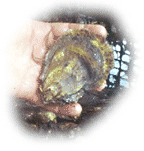Way Downstream
The Chesapeake Bay Program and Maryland Sea Grant College published a report this week with an eye-popping conclusion: If — and that’s a big if — Maryland and our neighbors can reduce the nutrient (nitrogen and phosphorus) pollution flowing into Chesapeake Bay, we could suddenly see swift and unpredictable improvements. Clear water could bring recovery in sudden bursts, and underwater grasses could flourish. After so much Bay gloom-and-doom, it’s a new way of thinking “that may help guide a path forward for the Chesapeake,” says Michael Kemp, a scientist at the University of Maryland Center for Environmental Science Horn Point Lab in Cambridge …

In Annapolis, the environmental activists made a point with chalk. Members of the Chesapeake Climate Action Network drew a new waterline across Main Street to show what would happen to the state capital if Greenland melted. Global warming could cause sea levels to rise 20 feet, they say, allowing the brackish waters to lap mid-way up Main Street …
Annapolitan Katie Ratigan will have to eat 25 pounds of milk chocolate, after winning the three-foot-tall Easter bunny raffled off by Alexander’s of Annapolis Salon and Day Spa to raise money for the SPCA. Fortunately, she’s got grandchildren to share with …
Around Maryland, vacationers enjoy mountains, Bay and beach for water sports, hiking and biking trails, city life and more. In 2006, more than 28 million Maryland visitors brought over $11.4 billion to Maryland, according to the Office of Tourism, generating some $895 million in state and local taxes. With rising gas prices, averaging in the $3.25 range — up some 64 cents a gallon from last year at this time according to the Energy Information Administration — vacationing near home makes good financial and environmental sense …
In Washington, the Chesapeake Bay Foundation has prevailed in a challenge to push the EPA to more stringently regulate the Blue Plains Wastewater Treatment Plant. That plant is one of the biggest polluters anywhere on the Chesapeake Bay, sending over six million pounds of nitrogen our way yearly via the Potomac River. This week, the EPA’s Environmental Appeals Board ruled in favor of the foundation, concluding that EPA had not constructed a timetable to swiftly force a clean up …
Worldwide, it’s lights out as the global community takes a timeout from wasteful electric consumption. March 29 at 8pm, the Earth Hour movement entreats you to turn off your power for an hour and help conserve electricity worldwide. Started as a citywide event in Sydney, Australia, in 2007, Earth Hour saved the equivalent of 48,000 cars traveling for an hour. This year, the movement has gone global, with over 200,841 people and 13,562 businesses committed to an hour without power. Join the movement at http://earthhour.org …

Our Creature Feature comes from Virginia, where our southern neighbors can’t seem to understand the widespread concerns about introducing Asian oysters into Chesapeake Bay. The Virginia Marine Resources Commission Seafood Council has given permission to grow more than one million sterile, ariakensis oysters in Virginia’s Bay waters, for the largest test ever. The Army Corps of Engineers must also approve the planting.
Native oysters in Maryland have suffered many of the same problems as Virginia’s, but here pro-Asian oyster sentiment largely disappeared when the National Academy of Sciences warned in 2005 that five to seven years of research would be necessary because of the risks. What could happen? The larger Chinese oysters could deliver diseases or out-compete our oysters, scientists said. Seafood marketers in Virginia say they’ve seen markets — but no problems …